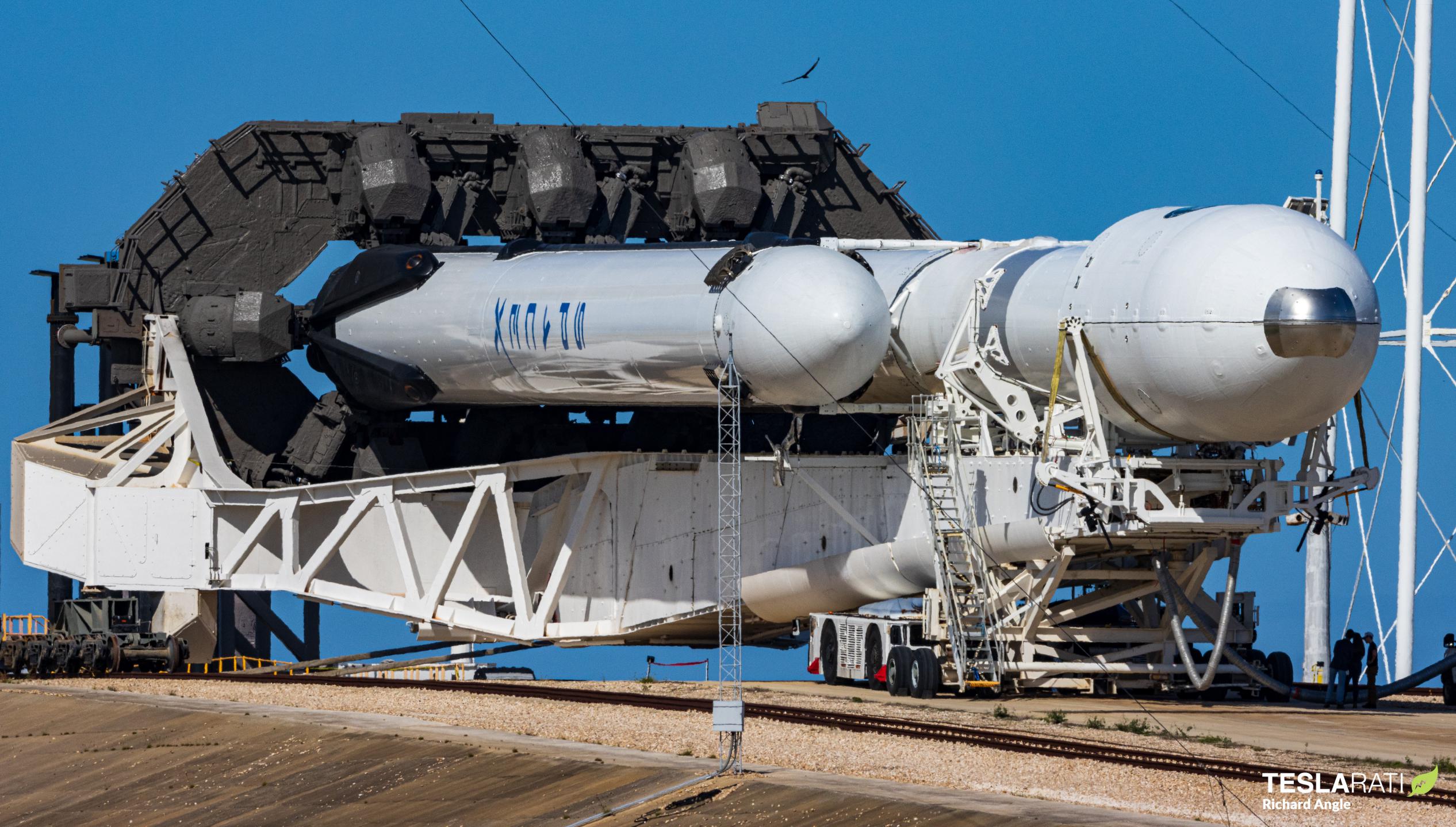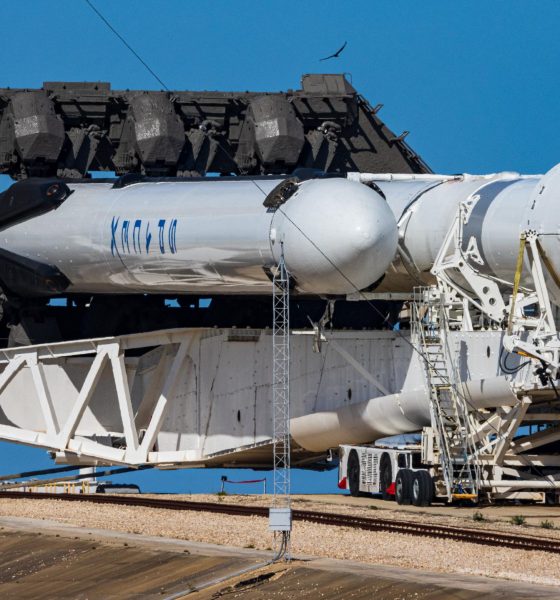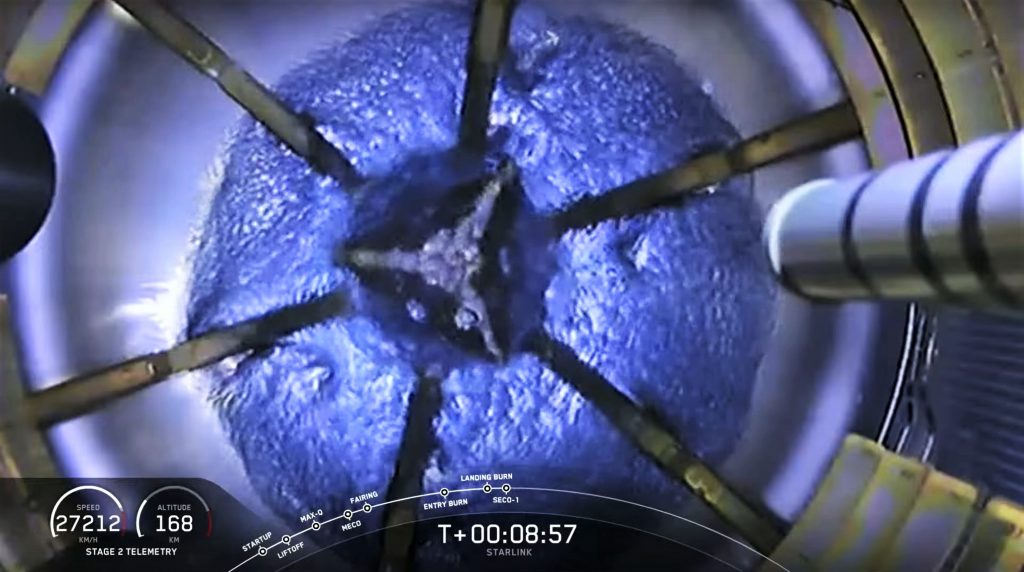

News
SpaceX Falcon Heavy rocket rolls to pad for Tuesday launch, dual booster landing
A SpaceX Falcon Heavy rocket has rolled out to Kennedy Space Center Pad 39A for its first launch (and dual booster landing) in almost three and a half years.
Missing its payload fairing and the US Space Force’s classified USSF-44 payload, SpaceX’s fourth Falcon Heavy rocket rolled out to Pad 39A for the first time on October 25th. On the 27th, the rocket successfully fired up all 27 of its first-stage Merlin 1D engines, reasserting its status as the most powerful operational rocket in the world. On October 30th, SpaceX finally brought Falcon Heavy horizontal and rolled the rocket back to Pad 39A’s integration hangar, where the USSF-44 mission’s several payloads – safely stowed inside a payload fairing – were installed on the rocket.
24 hours later, Falcon Heavy – now fully assembled – departed the hangar again. According to the US Space Systems Command (SSC), despite the exceptionally late rollout on October 31st, SpaceX is on track to launch Falcon Heavy no earlier than (NET) 9:41 am EDT (13:41 UTC) on Tuesday, November 1st.
As previously discussed on Teslarati, USSF-44 will be SpaceX’s first attempt at a direct launch to a geostationary orbit (GEO) some ~36,000 kilometers (~22,400 mi) above Earth’s surface, where spacecraft can hover motionless over their region of choice. To accomplish that feat, Falcon Heavy’s upper stage will need to survive a roughly six-hour coast in the harsh vacuum of space, likely making USSF-44 one of the most challenging missions SpaceX has ever attempted.
“Long orbital coasts of six or so hours are necessary for some of the most challenging launch trajectories. Direct-to-geostationary launches are the most common mission requiring long coast capabilities and are often demanded by the US military. When Falcon’s upper stage gets too cold, its kerosene fuel – which freezes at a much higher temperature than Falcon’s liquid oxygen oxidizer – becomes viscous and slush-like before it becomes solid. If ingested in Falcon’s Merlin Vacuum engine, slushy fuel would likely prevent ignition or outright destroy it.“
Teslarati.com – October 10th, 2022
Simultaneously, while worrying about kerosene fuel getting too cold, SpaceX must also ensure that the Falcon upper stage’s cryogenic liquid oxygen (LOx) oxidizer doesn’t boil into gas. If too much LOx warms up and has to be vented out as it turns to gas, the Falcon upper stage could find itself without enough propellant to complete its geostationary orbit circularization burn.
LOx is far less stable, which makes it a bit ironic that the upper stage’s fuel tank bares the only visible sign of the tweaks needed to survive a long coast. To keep the RP1 fuel warmer in orbit, SpaceX has added a layer of grey paint to the RP1 tank, increasing the amount of heat that can be absorbed through unfiltered sunlight. The uninsulated LOx tank, meanwhile, benefits from the unintuitive fact that a cryogenic liquid can stay liquid for a surprisingly long time because some of it warms up and boils off as a gas, sacrificing a small quantity to keep the rest cool.

According to the US Space Force, USSF-44 will carry several “various payloads” attached to the second Northrop Grumman “Long Duration Propulsive EELV (Evolved Expendable Launch Vehicle) Secondary Payload Adapter” or LDPE-2 – essentially a long-duration kick stage. Cataloged on EverydayAstronaut.com, the payloads include two Lockheed Martin LINUSS-A cubesats that will demonstrate a handful of new technologies and capabilities; TETRA-1, a microsat built by Millenium Space Systems to test on-orbit maneuverability; and a communications satellite prototype called USUVL. Spaceflight Now reports that LPDE-2 will carry three hosted payloads and deploy three satellites.
Finally, a recent Space Systems Command press release [PDF] mentioned a mysterious “Shepard demonstration” – likely a second propulsive kick stage – for the first time, which almost nothing is known about. It’s unclear if there is a main classified satellite the mission revolves around or if USSF-44 is simply a collection of various rideshare payloads headed to GEO.
Regardless, to launch them directly into geostationary orbit, USSF-44 will mark the first time SpaceX intentionally expends a Falcon Heavy booster. Over three previous launches, SpaceX only managed to land a Falcon Heavy center core once, but that core then tipped over and was destroyed at sea. Two other attempts resulted in failed landings. USSF-44 will continue that trend. Falcon Heavy’s twin side boosters will attempt to continue a more positive trend of simultaneous side-by-side landings and boost back to Florida to touch down at SpaceX’s LZ-1 and LZ-2 pads. SpaceX will also attempt to recover both halves of Falcon Heavy’s payload fairing a record-breaking 1410 kilometers (876 mi) off the Florida coast.
SpaceX says weather is 90% favorable for Falcon Heavy’s November 1st launch attempt. Stay tuned for a link to the company’s official webcast.

News
Waymo scrutinized after self-driving taxis cause traffic jams during SF blackout
It’s not farfetched to speculate that it would have been a doomsday scenario for Tesla had FSD behaved this way.

A power outage across San Francisco over the weekend forced numerous Waymo self-driving taxis to stop at darkened intersections and cause traffic blockages in multiple locations across the city. The disruption left riders stranded, frustrated drivers blocked, and city officials stepping in as the Alphabet-owned company temporarily suspended service amid the widespread gridlock.
Needless to say, it would likely have been a doomsday scenario for Tesla had FSD behaved in a similar way, especially if fleets of its robotaxis blocked traffic for numerous drivers.
Power outage halts Waymo fleet
The outage knocked out electricity for tens of thousands of customers, leaving traffic signals dark across large parts of the city, as noted in a report from the New York Times. Waymo vehicles began stopping at intersections and remained stationary for extended periods, seemingly unable to operate. Tow truck operators worked through the night removing immobilized vehicles, while videos circulated online showing Waymos with hazard lights flashing as traffic backed up around them.
Waymo later confirmed that it had paused its Bay Area ride-hailing service after the San Francisco mayor’s office contacted the company about the congestion its vehicles were contributing to. Service began coming back online shortly after 3:30 p.m. local time, though some users still reported being unable to request rides. Waymo maintained that no injuries or accidents were reported during the outage.
Autonomous cars during emergencies
The incident surprised industry observers since autonomous vehicles are designed to function during signal outages and temporary connectivity losses. Waymo stated that its vehicles treat nonfunctional signals as four-way stops, but “the sheer scale of the outage led to instances where vehicles remained stationary longer than usual to confirm the state of the affected intersections. This contributed to traffic friction during the height of the congestion.” Experts suggested the problem may have been linked to the vehicles’ reliance on remote assistance teams, which help resolve complex situations the cars cannot handle independently.
“Yesterday’s power outage was a widespread event that caused gridlock across San Francisco, with non-functioning traffic signals and transit disruptions. While the failure of the utility infrastructure was significant, we are committed to ensuring our technology adjusts to traffic flow during such events,” the Waymo spokesperson stated, adding that it is “focused on rapidly integrating the lessons learned from this event, and are committed to earning and maintaining the trust of the communities we serve every day.”
News
Tesla aims to combat common Full Self-Driving problem with new patent
Tesla writes in the patent that its autonomous and semi-autonomous vehicles are heavily reliant on camera systems to navigate and interact with their environment.

Tesla is aiming to combat a common Full Self-Driving problem with a new patent.
One issue with Tesla’s vision-based approach is that sunlight glare can become a troublesome element of everyday travel. Full Self-Driving is certainly an amazing technology, but there are still things Tesla is aiming to figure out with its development.
Unfortunately, it is extremely difficult to get around this issue, and even humans need ways to combat it when they’re driving, as we commonly use sunglasses or sun visors to give us better visibility.
Cameras obviously do not have these ways to fight sunglare, but a new patent Tesla recently had published aims to fight this through a “glare shield.”
Tesla writes in the patent that its autonomous and semi-autonomous vehicles are heavily reliant on camera systems to navigate and interact with their environment.

The ability to see surroundings is crucial for accurate performance, and glare is one element of interference that has yet to be confronted.
Tesla described the patent, which will utilize “a textured surface composed of an array of micro-cones, or cone-shaped formations, which serve to scatter incident light in various directions, thereby reducing glare and improving camera vision.”

The patent was first spotted by Not a Tesla App.
The design of the micro-cones is the first element of the puzzle to fight the excess glare. The patent says they are “optimized in size, angle, and orientation to minimize Total Hemispherical Reflectance (THR) and reflection penalty, enhancing the camera’s ability to accurately interpret visual data.”
Additionally, there is an electromechanical system for dynamic orientation adjustment, which will allow the micro-cones to move based on the angle of external light sources.
This is not the only thing Tesla is mulling to resolve issues with sunlight glare, as it has also worked on two other ways to combat the problem. One thing the company has discussed is a direct photon count.
CEO Elon Musk said during the Q2 Earnings Call:
“We use an approach which is direct photon count. When you see a processed image, so the image that goes from the sort of photon counter — the silicon photon counter — that then goes through a digital signal processor or image signal processor, that’s normally what happens. And then the image that you see looks all washed out, because if you point the camera at the sun, the post-processing of the photon counting washes things out.”
Future Hardware iterations, like Hardware 5 and Hardware 6, could also integrate better solutions for the sunglare issue, such as neutral density filters or heated lenses, aiming to solve glare more effectively.
Elon Musk
Delaware Supreme Court reinstates Elon Musk’s 2018 Tesla CEO pay package
The unanimous decision criticized the prior total rescission as “improper and inequitable,” arguing that it left Musk uncompensated for six years of transformative leadership at Tesla.

The Delaware Supreme Court has overturned a lower court ruling, reinstating Elon Musk’s 2018 compensation package originally valued at $56 billion but now worth approximately $139 billion due to Tesla’s soaring stock price.
The unanimous decision criticized the prior total rescission as “improper and inequitable,” arguing that it left Musk uncompensated for six years of transformative leadership at Tesla. Musk quickly celebrated the outcome on X, stating that he felt “vindicated.” He also shared his gratitude to TSLA shareholders.
Delaware Supreme Court makes a decision
In a 49-page ruling Friday, the Delaware Supreme Court reversed Chancellor Kathaleen McCormick’s 2024 decision that voided the 2018 package over alleged board conflicts and inadequate shareholder disclosures. The high court acknowledged varying views on liability but agreed rescission was excessive, stating it “leaves Musk uncompensated for his time and efforts over a period of six years.”
The 2018 plan granted Musk options on about 304 million shares upon hitting aggressive milestones, all of which were achieved ahead of time. Shareholders overwhelmingly approved it initially in 2018 and ratified it once again in 2024 after the Delaware lower court struck it down. The case against Musk’s 2018 pay package was filed by plaintiff Richard Tornetta, who held just nine shares when the compensation plan was approved.
A hard-fought victory
As noted in a Reuters report, Tesla’s win avoids a potential $26 billion earnings hit from replacing the award at current prices. Tesla, now Texas-incorporated, had hedged with interim plans, including a November 2025 shareholder-approved package potentially worth $878 billion tied to Robotaxi and Optimus goals and other extremely aggressive operational milestones.
The saga surrounding Elon Musk’s 2018 pay package ultimately damaged Delaware’s corporate appeal, prompting a number of high-profile firms, such as Dropbox, Roblox, Trade Desk, and Coinbase, to follow Tesla’s exodus out of the state. What added more fuel to the issue was the fact that Tornetta’s legal team, following the lower court’s 2024 decision, demanded a fee request of more than $5.1 billion worth of TSLA stock, which was equal to an hourly rate of over $200,000.
Delaware Supreme Court Elon Musk 2018 Pay Package by Simon Alvarez








